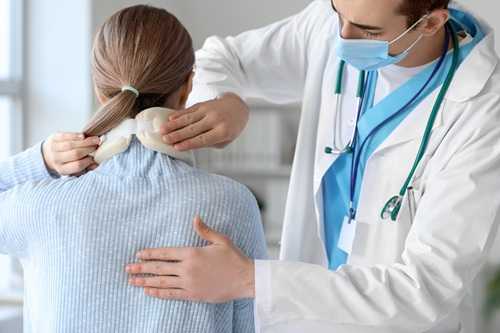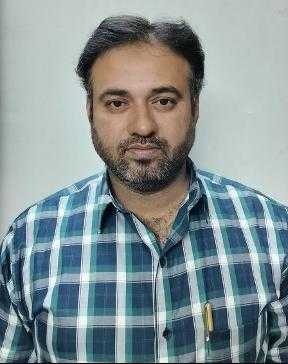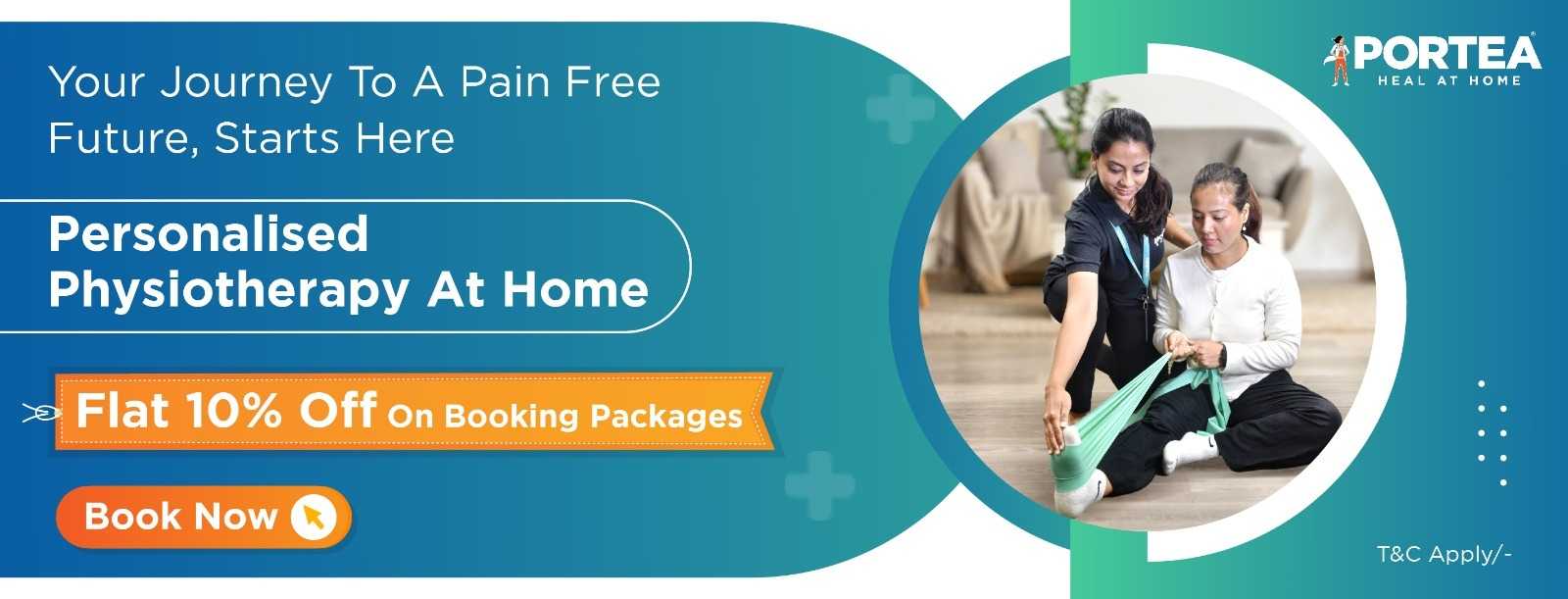
Expert Physiotherapy at Home
Certified physiotherapists visit you at home to provide focused, one-on-one care tailored to your needs. With no travel or waiting rooms, recovery happens in a setting that is comfortable, familiar, and built around your convenience.
Personalised Recovery Programmes
Every treatment plan is designed to suit your condition, goals, and pace. Our physiotherapists follow structured, evolving protocols to ensure consistent progress, with each session aligned to deliver meaningful results.
Trusted Physiotherapists. Real Results.
Our team comprises experienced, background-verified physiotherapists trusted by thousands of families. With a strong focus on safety, reliability, and clinical outcomes, we make recovery at home both effective and reassuring
Patient Testimonials
Portea Physiotherapists for Home Visits
Meet some of our experienced and dedicated healthcare professionals

Dr. Lokesh G
Physiotherapist
Specializations
Experienced in Neurological rehabilitation, Orthopaedic physiotherapy, and Paediatric care
Delivers structured, high-impact treatment plans across neuro, ortho, and paediatrics—ensuring safety, comfort, and measurable recovery at every stage.

Dr. Mohammed Sarwar
Physiotherapist
Specializations
Experienced in Neurological rehabilitation, Adult physiotherapy, and Paediatric care
Combines deep clinical expertise with a compassionate approach, supporting both adults and children through neuro and physical rehabilitation that promotes long-term independence and recovery.

Dr. Nelapati Divya
Physiotherapist
Specializations
Skilled in Orthopaedic rehabilitation, Manual therapy techniques, and Paediatric physiotherapy
Brings a personalised, hands-on approach to healing—combining structural expertise with paediatric sensitivity to restore movement, relieve pain, and improve everyday function.

Dr. Naveen V
Physiotherapist
Specializations
Trained in Pain management, Cardiac and Orthopaedic rehabilitation, Neurological care, and Neural tissue mobilisation
Brings clinical precision and empathy together—designing science-backed recovery protocols for pain relief, nerve mobilisation, and cardio-neuro-ortho rehabilitation across all age groups

Dr. Miloni Savla
Physiotherapist
Specializations
Holds an MPT in Orthopaedics with a focus on Musculoskeletal rehabilitation and strength recovery
Delivers focused, movement-oriented therapy grounded in orthopaedic science—helping patients rebuild strength, restore function, and return to daily life with confidence
Other Cities
Physiotherapy Treatments

introduction
Torticollis, commonly known as “wry neck,” is a condition characterized by abnormal, involuntary tilting or rotation of the head due to muscle contractions in the neck. It can be congenital (present at birth) or acquired due to injury, muscle spasms, or neurological disorders. Torticollis rehabilitation focuses on restoring neck mobility, reducing pain, and improving posture through targeted treatments and therapies.
causes of torticollis
Torticollis can have various underlying causes, which influence the rehabilitation approach:
- Congenital Torticollis: This condition is often caused by the shortening or tightening of the sternocleidomastoid muscle in newborns, leading to restricted movement and abnormal head positioning. It may be linked to the baby’s position in the womb or birth trauma.
- Acquired Torticollis: This can develop later in life due to muscle strain, infections, trauma, or prolonged poor posture. Certain activities, such as prolonged desk work or using mobile devices incorrectly, can contribute to muscle imbalance and stiffness in the neck.
- Spasmodic Torticollis (Cervical Dystonia): A neurological disorder that causes involuntary muscle contractions, leading to painful, abnormal head postures. This condition is often chronic and may worsen over time if left untreated.
- Other Causes: Infections, inflammation, or even certain medications can trigger torticollis by affecting the nervous system or muscles in the neck.
symptoms and diagnosis
Common symptoms of torticollis include:
- Head tilting to one side with limited range of motion
- Neck pain and stiffness
- Muscle tightness and spasms
- Headaches or dizziness
- Shoulder elevation on the affected side
- Fatigue due to continuous muscle strain
- Difficulty maintaining an upright posture
Diagnosis typically involves a physical examination, medical history evaluation, and imaging tests like X-rays, MRIs, or CT scans to determine the cause and severity of the condition. Electromyography (EMG) may also be used to assess muscle activity and nerve function.
non-surgical rehabilitation approaches
1. Physical Therapy for Torticollis
Physical therapy is a cornerstone of torticollis rehabilitation, providing targeted exercises and hands-on techniques to improve mobility and function. Some key components include:
- Stretching Exercises: Gentle, sustained stretches help lengthen tight muscles and gradually restore normal range of motion. These exercises should be performed regularly for optimal results.
- Strengthening Exercises: Weak muscles contribute to poor head positioning. Strengthening exercises target the neck, shoulders, and upper back to provide better support and alignment.
- Manual Therapy: Hands-on techniques, such as myofascial release, joint mobilization, and trigger point therapy, can alleviate stiffness and reduce pain.
- Postural Training: Teaching patients to maintain proper alignment while sitting, standing, and sleeping prevents muscle imbalances and reduces strain on the neck.
- Heat and Cold Therapy: Heat application can relax tight muscles, while cold therapy helps reduce inflammation and pain, especially in acute cases.
- Kinesiology Taping: Some physical therapists use specialized taping techniques to provide additional support and facilitate correct muscle function.
2. Medications for Symptom Relief
Certain medications may be prescribed to manage symptoms and improve comfort:
- Muscle Relaxants: These help alleviate muscle stiffness and spasms.
- Pain Relievers: Nonsteroidal anti-inflammatory drugs (NSAIDs) like ibuprofen or acetaminophen can help reduce discomfort.
- Botulinum Toxin (Botox) Injections: These are commonly used for spasmodic torticollis to temporarily paralyze overactive muscles, providing significant relief from involuntary contractions.
3. Bracing and Orthotic Support
For some patients, soft cervical collars or braces can help maintain proper head positioning and provide additional support. This is particularly useful for infants with congenital torticollis, as early intervention can prevent long-term complications.
advanced treatment options
If conservative treatments do not provide sufficient relief, advanced interventions may be considered.
1. Neuromodulation Therapy
- Electrical stimulation techniques may be used to retrain muscle function and reduce abnormal contractions.
- Deep brain stimulation (DBS) is an option for severe cases of cervical dystonia, where electrodes are implanted to regulate muscle activity.
2. Surgical Intervention
Surgery is rarely required but may be considered in severe or persistent cases that do not respond to other treatments. Common surgical options include:
- Sternocleidomastoid Release Surgery: This procedure involves lengthening the muscle to restore proper movement and reduce head tilt.
- Selective Nerve or Muscle Procedures: In cases of severe spasmodic torticollis, selective nerves or muscle groups may be cut to relieve chronic contractions and pain.
- Spinal Fusion or Decompression: In rare cases, when torticollis is linked to structural abnormalities in the spine, corrective spinal surgery may be necessary.
home-based exercises and lifestyle modifications
Patients can support their rehabilitation through consistent home-based exercises and lifestyle modifications:
- Daily Stretching Routines: Simple neck stretches help maintain flexibility and prevent stiffness.
- Workplace Ergonomics: Adjusting desk height, using supportive chairs, and taking breaks from screen time can prevent poor posture from contributing to symptoms.
- Stress Management Techniques: Practices such as deep breathing, yoga, and mindfulness meditation can reduce tension and help manage pain.
- Supportive Sleeping Positions: Using a contoured pillow and maintaining proper head positioning while sleeping can alleviate strain on the neck.
- Hydration and Nutrition: Staying hydrated and ensuring proper nutrient intake, including magnesium and vitamin D, can support muscle function and recovery.
how portea supports torticollis rehabilitation
At Portea, we provide expert physiotherapy services tailored to individuals with torticollis. Our rehabilitation programs focus on pain relief, improved mobility, and long-term management strategies. Beyond torticollis treatment, we specialize in a range of physiotherapy services, including post-surgical rehabilitation, arthritis care, neuro-rehabilitation, sports injury recovery, orthopedic care, elderly physiotherapy, and respiratory therapy—all delivered at home for maximum convenience. With our dedicated and experienced team, we ensure that each patient receives professional, customized care to enhance their recovery and improve their quality of life.
faqs
1.What treatments are used for torticollis?
Treatments include stretching exercises, physical therapy, manual techniques, and postural corrections. In severe cases, Botox injections or surgery may be recommended. Therapy focuses on relieving muscle tightness, enhancing flexibility, and restoring normal neck movement, ensuring long-term relief and functional improvement.
2.Who needs torticollis treatment?
Torticollis treatment benefits infants with congenital torticollis and adults with acquired torticollis from injury, poor posture, or muscle spasms. Early intervention helps prevent complications, improves mobility, and reduces discomfort. A customized rehabilitation plan ensures effective recovery based on age, severity, and individual needs.
3.How long does torticollis rehabilitation take?
Recovery time varies based on severity and consistency of treatment. Mild cases may improve within weeks, while severe cases can take months. Regular therapy sessions, home exercises, and posture adjustments help accelerate progress and ensure lasting improvements in neck mobility and comfort.
4.Can torticollis be treated at home?
Mild torticollis can be managed with guided exercises, stretches, and posture corrections at home. However, professional therapy ensures proper techniques and faster recovery. Severe cases require expert intervention for effective treatment and to prevent long-term complications like restricted movement or chronic pain.
5.Is torticollis rehabilitation painful?
Therapy is usually gentle, but mild discomfort may occur as muscles stretch and adjust. Therapists use pain-relief techniques like massage and gradual stretching to minimize discomfort. Consistent therapy helps strengthen muscles, improve flexibility, and reduce stiffness over time.
Doctor Consultation
Nursing
Physiotherapy
Trained Attendant
Elder Care
Mother & Baby Care
Lab Tests
Medical Equipment
Speciality Pharma
Critical Care




